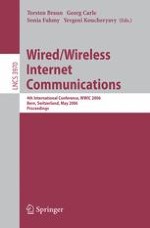Welcome to the proceedings of the 4th International Conference on Wired/ Wireless Internet Communications held at the University of Bern from May 10–12,2006. As in 2005,WWIC was selected as the o?cial conference by COST Action 290, and Springer accepted to publish the conference proceedings in the LNCS series. These facts have helped to again attract a large number of hi- quality paper submissions. We received 142 submissions out of which 29 papers were selected by the International Program Committee for presentation at the conference. This resulted in a low acceptance rate of 21%. To limit the load on individual Program Committee members, we increased the Technical Program Committee sizeto 63 members. An additional60reviewerssupportedthe review process. We would like to thank all TPC members and reviewers for their ca- ful reviews, Microsoft Research for providing the online conference management toolkit, and TNO Delft for hosting the physical TPC meeting. The selected papers are organized into eight sessions on the following topics: – Wireless Networks – UMTS and OFDM – Mobile Ad-Hoc Networks – Power Saving and Sensor Networks – Voice and Video Over Wireless Networks – Mobility – TCP – Signalling, Charging, and Security The selected presentations and invited talks from distinguished international speakers formed an extremely exciting program. We hope that all attendees enjoyed both the scienti?c and social program as well as the city and the s- roundings of Bern, the capital of Switzerland.
